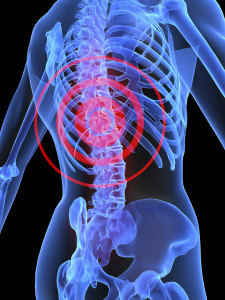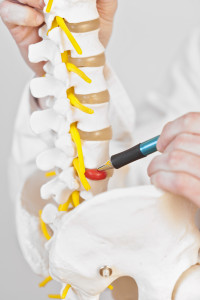SPINE PAIN & INJURY CARE AT AOSMI IN FREEHOLD, NJ
Reviewed by AOSMI’s Fellowship Trained, Orthopedic Spine Surgeon, Dr. Justin Elkrief.

Most people will experience minor back problems and pain at one time or another.
Whether you have a disc problem, spinal stenosis, spinal cord injury or a lumbar strain, you’ll get the best possible care from the board-certified New Jersey spine doctors at Advanced Orthopedics and Sports Medicine Institute.
Your risk of back pain increases as you age, if you have a family history of back pain, sit for long periods, lift heavy objects or have a degenerative disease, such as osteoporosis. Most spinal problems occur in adults aged 20 to 50, but if they occur in children under the age of 20 or in adults over the age of 50, they’re more likely to have a serious cause. Symptoms may begin gradually, and occur most often from improper movement or posture while lifting, standing, walking, sitting, or even sleeping. The pain often goes away within four weeks without treatment. If your pain is severe or lasts longer than expected, the specialists at AOSMI of NJ can provide immediate diagnosis and treatment.
COMMON SPINAL INJURIES & DISEASES CONDITIONS TREATED AT AOSMI
Common conditions that cause back pain and may require spinal care include:
- Sudden (acute) Spinal injuries
- An injury to the muscles or ligaments in the back such as a sprain
- A fracture or dislocation of the spine, which may lead to permanent paralysis
- A torn or ruptured disc (herniated disc)
- Compression of the nerves in the lower back (cauda equina syndrome)
- Chronic Spine Diseases
- Spinal Stenosis – The joints of the spine become enlarged and the spinal nerves can be compressed
- Spondylosis – Inflammation and arthritis of the joints in the spine
- Spondylolisthesis – Slipping of one spinal bone over another, usually can be caused by degeneration
- Degenerative Disc Disease – The discs become dry and shrink, and the edges of the bones rub on one another
- Overuse Injuries of the Spine
- Often caused by using poor body mechanics while lifting or working in an uncomfortable position for extended periods of time. This leads to degeneration, muscle spasm and pain.
- Often caused by using poor body mechanics while lifting or working in an uncomfortable position for extended periods of time. This leads to degeneration, muscle spasm and pain.
Non-Operative Spine Injury Treatments

Whether you’ve had a spine problem for some time or just started experiencing back pain, spine specialists at AOSMI can help you find the cause and get you on the road to recovery – often the same day. Most spine and back pain can be relieved without the need for invasive treatment or surgery. The board certified orthopedic spine doctors at AOMS offer swift, accurate diagnosis and immediate pain management. Your team of specialists will explore all avenues of spine injury treatment before recommending surgery to treat your back pain. Some of these non-surgical spine treatment options are:
Common Spine Surgery Procedures
We treat degenerative diseases of cervical and lumbar spine, tumors, fractures, infections, and scoliosis. Our spine surgeons have extensive experience in the field of minimally invasive spine surgery and motion preserving spine surgery. Here is a list of common procedures performed at the AOSMI Spine Center.
- Microdiskectomy – Remove damaged disk through tiny incisions
- Microlaminectomy (Spinal Cord Compression Treatment) – Open up area compressing spinal cord
- Microforaminotomy – Open up area around compressed nerves
- Endoscopic Diskectomy – Remove damaged disk through tiny incisions
- Minimally Invasive Fusion – Cause segments of the spine to bond together, eliminating pain
- Disk Replacement – Replacement of damaged disk with artificial joint
- Surgical Treatment of Chronic Pain – Nerve stimulators
- Laser Spine Surgery – Remove damaged tissue through tiny incisions
- Kyphoplasty – Minimally invasive procedure that supports a spine fracture with bone cement
Visit our clinic in Freehold, NJ for a consultation and find out what treatments are appropriate for you.
Frequently Asked Questions About Spine Pain & Injuries
What are the main causes of spine pain?
Spine pain can be caused by a variety of factors, including:
- Muscle Strain: Overuse or improper use of back muscles can lead to strains and discomfort.
- Herniated Disc: When the gel-like material within a spinal disc pushes through its outer layer, it can irritate nearby nerves.
- Spinal Stenosis: Narrowing of the spinal canal can put pressure on the spinal cord and nerves.
- Osteoarthritis: Wear and tear of the spinal joints can cause pain and stiffness.
- Scoliosis: Abnormal curvature of the spine can lead to pain and discomfort.
- Fractures: Broken vertebrae due to trauma or osteoporosis can cause severe pain.
- Infections or Tumors: Rarely, infections or tumors can affect the spine and cause pain.
How do you know if spine pain is serious?
Serious spine pain may be indicated by:
- Severe Pain: Intense, persistent pain that does not improve with rest or over-the-counter medications.
- Numbness or Weakness: Loss of sensation or muscle weakness, especially in the legs, can indicate nerve compression.
- Bowel or Bladder Dysfunction: Difficulty controlling bowel or bladder function may be a sign of a serious nerve problem.
- Unintended Weight Loss: Rapid weight loss without explanation could suggest an underlying issue.
- Pain at Night: Pain that worsens at night or interrupts sleep might require medical attention.
- Pain After Trauma: Pain following a fall, accident, or injury requires evaluation.
Can a damaged spine heal without surgery?
In many cases, damaged spines can heal without surgery. Non-surgical treatments include:
- Rest and Activity Modification: Avoiding activities that worsen the pain and gradually returning to normal activities.
- Physical Therapy: Exercises to improve strength, flexibility, and posture can aid in healing.
- Medications: Pain relievers, anti-inflammatories, and muscle relaxants can help manage pain and inflammation.
- Injections: Epidural injections of corticosteroids can reduce inflammation and pain.
- Bracing: Depending on the condition, bracing might be recommended to support and stabilize the spine.
- Lifestyle Changes: Weight management, smoking cessation, and proper ergonomics can promote healing.
How do you get rid of spinal cord pain?
Getting rid of spinal cord pain typically involves addressing the underlying cause. Treatments may include:
- Conservative Care: Non-surgical approaches, such as physical therapy, medications, and lifestyle changes.
- Surgery: Surgical intervention might be necessary for conditions like herniated discs, spinal stenosis, or severe fractures.
- Minimally Invasive Procedures: Techniques like endoscopic discectomy or spinal fusion aim to minimize tissue damage and recovery time.
- Pain Management Techniques: Nerve blocks, radiofrequency ablation, and spinal cord stimulation can help manage chronic pain.
- Rehabilitation: Post-surgery or injury, rehabilitation can aid in restoring function and reducing pain.
What can cause spine pain without injury?
Spine pain without a direct injury can be attributed to:
- Degenerative Conditions: Conditions like osteoarthritis and degenerative disc disease can cause gradual spine pain.
- Poor Posture: Prolonged poor posture can strain spinal structures and lead to pain.
- Muscle Imbalances: Weak or tight muscles can disrupt spinal alignment and cause discomfort.
- Lifestyle Factors: Obesity, lack of exercise, and smoking can contribute to spine pain.
- Medical Conditions: Conditions like fibromyalgia or infections can cause non-specific spine pain.
What are some common spinal cord injury treatments?
Treatment options for spinal cord injuries depend on the severity and location of the injury and may include:
- Immobilization: Stabilizing the spine with braces or traction to prevent further damage.
- Surgery: Surgical intervention to realign and stabilize the spine, remove fragments, or decompress nerves.
- Rehabilitation: Physical therapy, occupational therapy, and other forms of rehabilitation to regain function and independence.
- Medications: Pain management medications and drugs to control muscle spasticity.
- Assistive Devices: Wheelchairs, braces, and other devices to aid mobility and daily activities.
- Experimental Treatments: Ongoing research into stem cell therapy and nerve regeneration techniques.







